Germany are one of the favourites for the 2023 Women’s World Cup. The team of national coach Martina Voss-Tecklenburg has a strong mix of experience and youth. Her squad boasts a number of world-class players. Since the first edition of the World Cup in 1991, Germany have won the competition twice — in 2003 and 2007. In addition, the DFB-Frauen were in the semi-finals twice and became vice-world champions in 1995 after losing the final against Norway. The DFB team also has a good chance of going far in the finals in Australia and New Zealand. Germany were in the final of the 2022 European Championships and only had to admit defeat to England after a dramatic overtime. Germany also impressed in the World Cup qualifiers with nine wins in ten games and an average of 4.7 goals per game.
The German women’s national team enters the upcoming tournament with great anticipation and faces an exciting challenge. The first group game against Morocco is scheduled for July 24th. The German team will be highly motivated to get the tournament off to a positive start and collect the first important points. The second group match will take place on July 30th against Colombia. The last group game against South Korea is scheduled for August 3rd. This game will be crucial to determine group placement and secure a good starting position for the knockout stages. In case of a successful performance in the group stage, the German team would play in the round of 16 on August 8th.
The players and the coaching staff will work hard to prepare as well as possible for each matchday. The goal is to successfully progress in the tournament through strong performances and teamwork and to maintain the possibility of successfully defending the title. The fans can look forward to exciting games and thrilling football when the German women’s national team is on the field. In our tactical analysis and team-focused scout report, we aim to provide some in-depth analysis of Germany, Voss-Tecklenburg’s tactics and the key talking points regarding their performance in offensive, defensive and transitional phases.
Predicting Starting XI
The team of vice European champions is led by captain Alexandra Popp and goalkeeper Merle Frohms from VfL Wolfsburg. Chelsea midfielder Melanie Leupolz was called up to the squad just eight months after the birth of her son.
In addition to Giulia Gwinn from Bayern Munich, goalkeeper Almuth Schult (pregnancy) and Gwinn’s teammate Linda Dallmann (syndrome tear) are also missing from the squad. The core of the squad consists of the players from Champions League finalists VfL Wolfsburg (10), followed by Eintracht Frankfurt (6) and Bayern (5). In addition to the 28 nominees for the provisional squad, 10 other players are available on call.
Overall, Germany’s Women’s National Team possesses a talented and balanced squad with a mix of experienced players and promising youngsters. Under the guidance of their coach, they will aim to showcase their skills, tactical understanding, and teamwork to compete at the highest level in the World Cup.
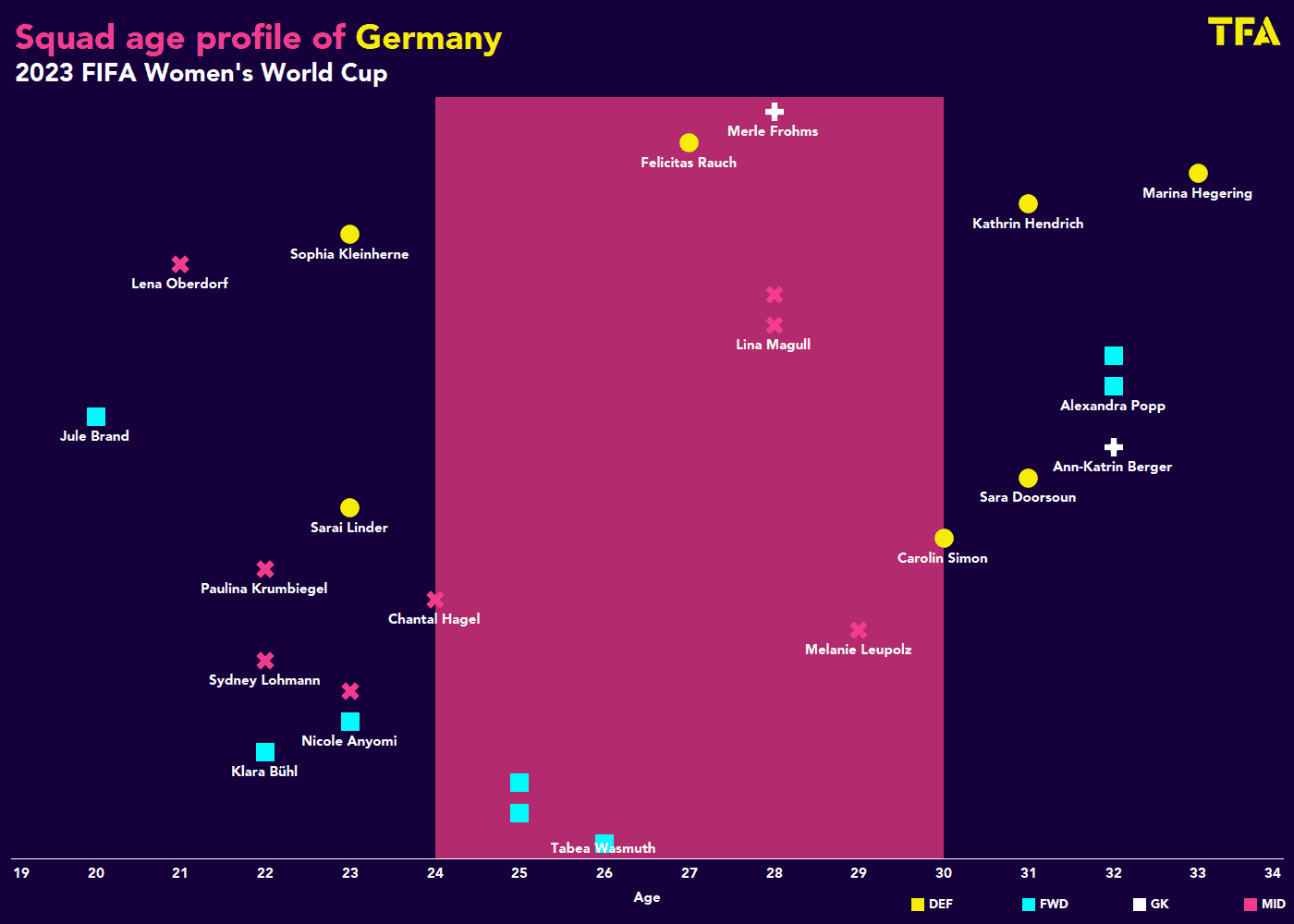
In the upcoming World Cup in 2023, Germany’s Women’s National Team is expected to field a strong lineup in a 4-3-3 formation. Let’s take a closer look at the potential starting eleven and key players:
Merle Frohms, at 28 years old, is likely to be the team’s starting goalkeeper. With her experience and shot-stopping abilities, she will provide a solid presence between the posts.
Felicitas Rauch, Marina Hegering, Kathrin Hendrich, and Sophia Kleinherne are expected to form the defensive line. Rauch will likely operate as the left-back, while Hegering and Hendrich occupy the central defensive positions as the left and right centre-backs, respectively. Kleinherne will provide attacking impetus from the right-back position.
In the midfield, Lena Oberdorf is a promising talent at just 21 years old and is expected to play a crucial role as a central midfielder. Alongside her, Sara Däbritz and Lina Magull are likely to feature as the left and right central midfielders, respectively, providing a blend of creativity and defensive solidity.
The attacking trio consists of Svenja Huth, Alexandra Popp, and Jule Brand. Huth is likely to operate on the left wing, using her speed and dribbling skills to create scoring opportunities. Popp, the team’s captain, will lead the line as the central forward, utilising her physical presence and goal-scoring prowess. Brand, a young talent at 20 years old, is expected to feature on the right wing, showcasing her skills and contributing to the team’s attacking threat.
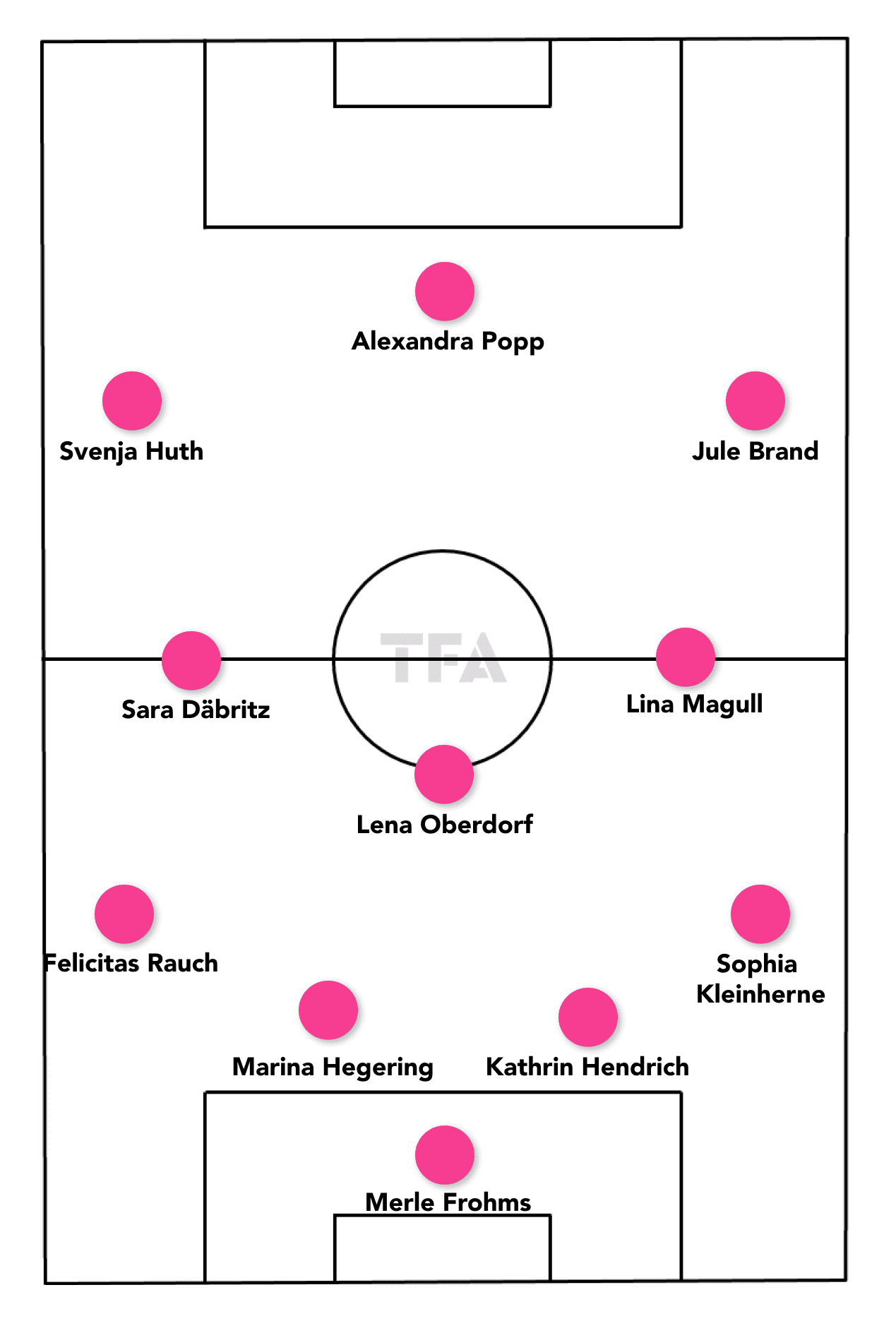
Ann-Katrin Berger provides valuable goalkeeping cover, while players like Sara Doorsoun, Sarai Linder, Carolin Simon, Paulina Krumbiegel, Chantal Hagel, Melanie Leupolz, Sydney Lohmann, Lena Lattwein, Nicole Anyomi, Klara Bühl, Laura Freigang, Lea Schüller, and Tabea Waßmuth offer depth and options across the team.
Attacking Phase
Before delving into specific aspects of the team and the available options under Voss-Tecklenburg, it is important to outline some fundamental points about her tactics and strategies as the coach of the German national team. This analysis will provide an overview of their attacking style, defensive approach, and transitional play. By examining these different phases, we can better understand our choices for the starting lineup and potentially gain insight into Voss-Tecklenburg’s provisional squad selections.
Germany’s style of play is characterised by a combination of ball dominance and verticality. They prioritise moving the ball forward frequently and playing in a vertical manner, as reflected in their high ranking in forward passes per match. Rather than taking long shots, they focus on working the ball into high-quality shooting positions with an expected goals-per-shot value over average. This approach leads to greater shooting accuracy and efficiency in their offensive play. Their set-pieces are one of their biggest weapons.
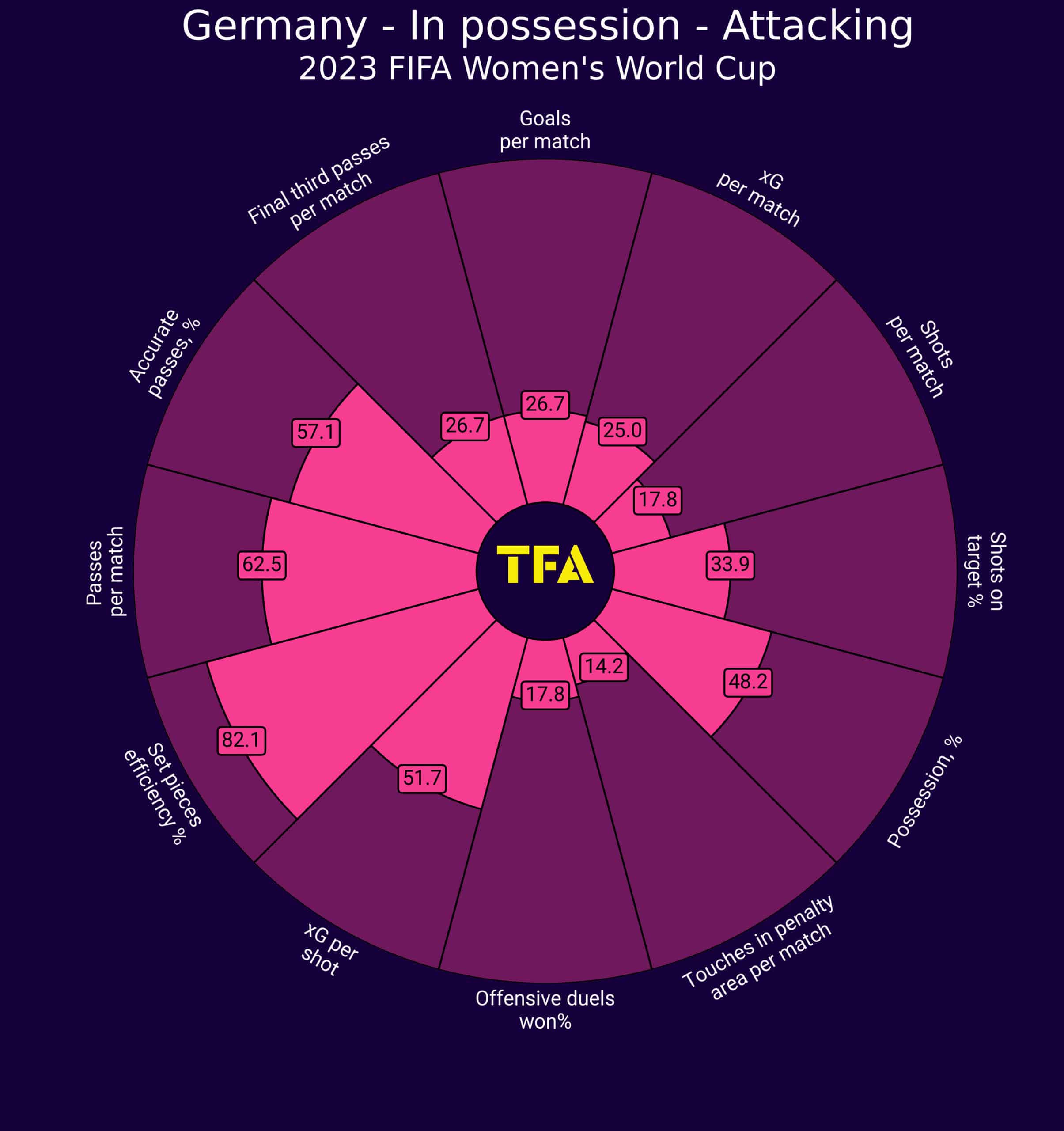
Germany’s offensive shape often transitions from a 4-3-3 to a 2-4-1-3 or 2-3-2-3 formation, depending on the positioning of the midfielders. The centre-backs provide a solid foundation in the offensive structure, while the full-backs push forward to flank the midfield trio. The full-backs play a crucial role in providing width to the team’s attacking play as it progresses up the field.
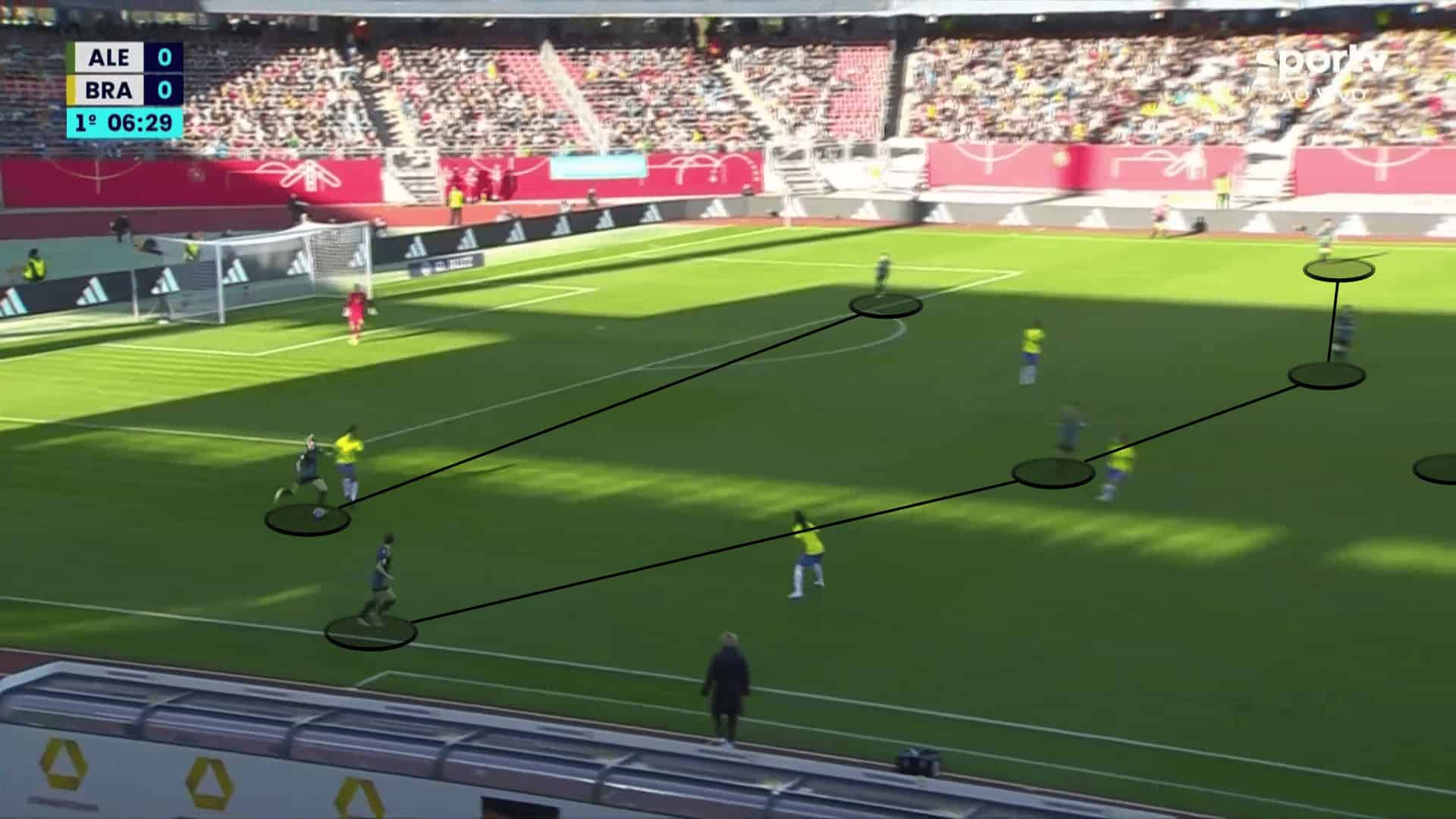
The midfielders display fluidity and dynamic movement. While the holding midfielder tends to stay slightly deeper, the other two midfielders have the freedom to roam. They can form a double-pivot alongside the holding midfielder or push higher up the pitch, often rotating with their midfield partner in the ‘8’ position.
The forwards adopt a narrow positioning and engage in alternating movements. Some forwards look to connect with the midfielders and participate in combination play, while others make sharp diagonal runs behind the opposition’s defensive line, creating numerous options for the deeper players.
During the early attacking phase, Germany displays a distinct pattern. The centre-backs split wide on either side of the goalkeeper, who takes on the role of a sweeper-keeper. This allows the goalkeeper to act as a third centre-back during build-up and ball progression.
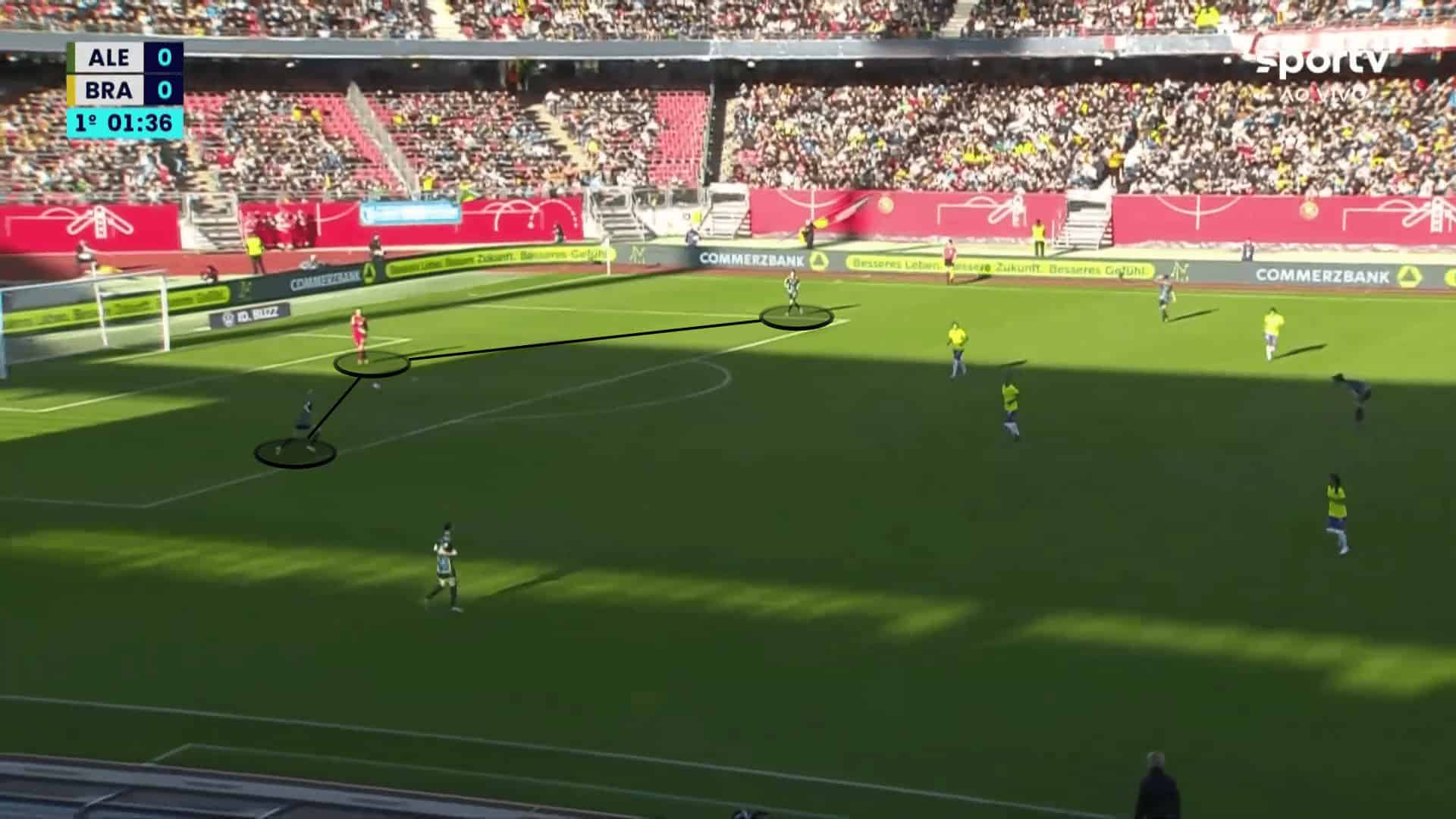
Positioning the centre-backs wide creates space for the goalkeeper to venture outside the box and fulfil the sweeper-keeper role. This bold movement prompts the full-backs to push forward, as the centre-backs now occupy the area that would typically be occupied by the full-backs. Consequently, the full-backs are encouraged to operate on either side of the midfield, aligning with Voss-Tecklenburg’s tactical preference.
This tactical approach helps Germany in dominating possession, breaking past the opposition’s initial defensive line, and provides the full-backs with the freedom to contribute to the team’s attacking play.
In the attacking phase, Germany relies on their full-backs to provide offensive width, while the wingers tend to position themselves more centrally, making diagonal runs behind the opposition’s backline.
Germany’s wide forwards often make inward-to-outward runs, penetrating the gaps between the centre-back and full-back of the opposing team’s defence. Simultaneously, Germany’s full-backs frequently embark on dynamic surges forward from deeper positions.

This tactical approach allows Germany to create multiple attacking options, exploiting the spaces behind the opposition’s defence through intelligent runs and overlapping movements by the full-backs.
Overall, Germany’s offensive approach emphasises flexibility, movement, and the utilisation of various passing and running options to create effective attacking opportunities.
Defensive Phase
Germany displays an aggressive defensive style under Voss-Tecklenburg’s guidance. Their aim is to regain possession far from their own goal but near the opposition’s goal, allowing for quick counter-attacks and scoring opportunities in dangerous positions. This strategy is supported by Germany’s low ranking in PPDA (Passes Per Defensive Action), indicating their willingness to press and disrupt the opponent’s build-up.
The team excels in defensive metrics such as recoveries per match, defensive duels per match, and aerial duels per match. These statistics reflect Germany’s proactive defensive approach and contribute to their dominance in possession. The squad is composed of players with the necessary defensive profiles to execute this high-intensity style of play.
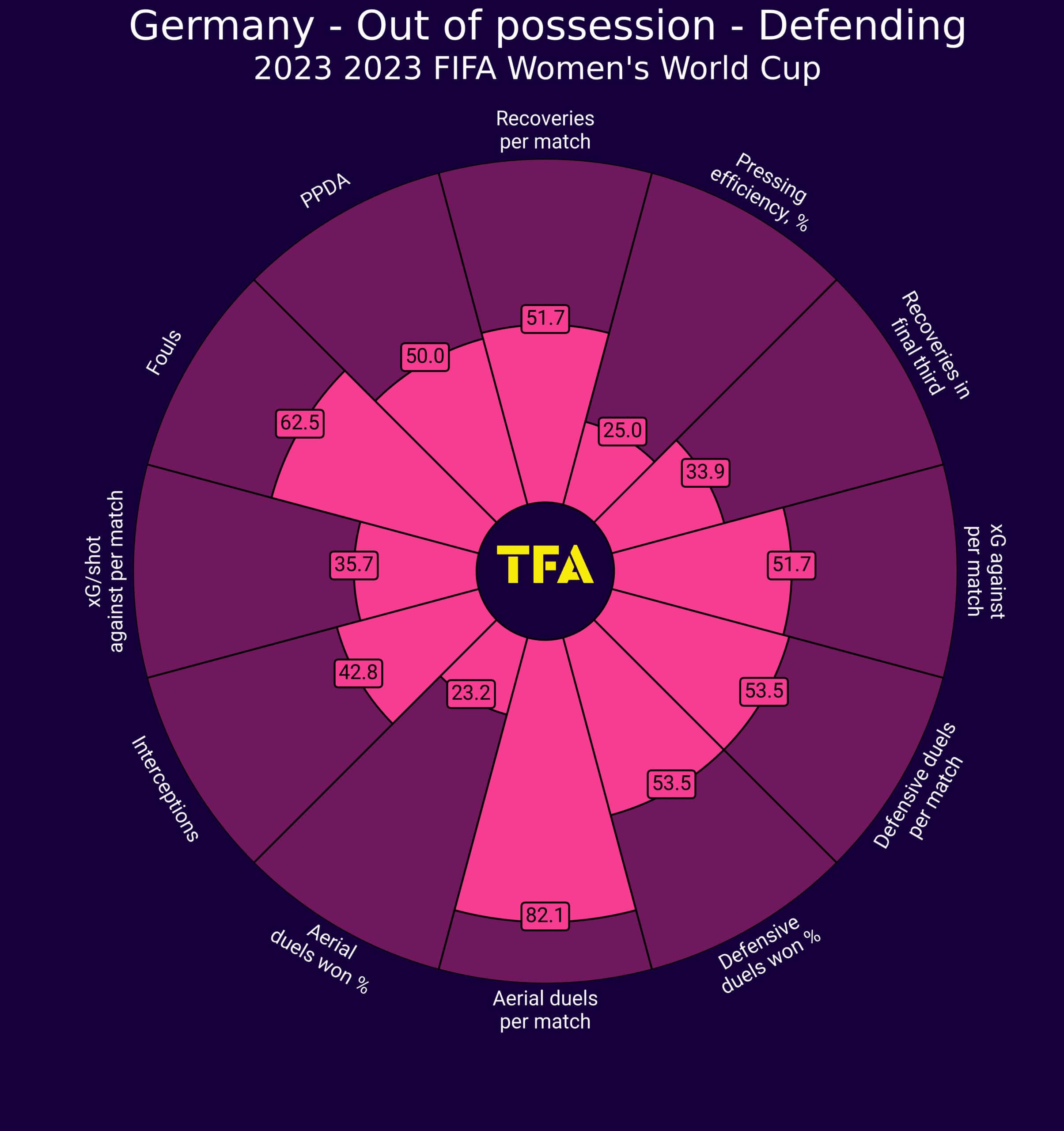
Germany’s centre-forward plays a crucial role if the ball is passed back to the opposition goalkeeper. Her responsibility is not only to apply immediate pressure on the goalkeeper but also to close the passing lanes to the opposite wing and prevent the goalkeeper from executing a potential switch of play. Allowing the goalkeeper to turn out would be detrimental to Germany’s defensive structure since their players are currently oriented towards the left wing. It is essential to keep the pitch divided and confine the opposition to one side, which the centre-forward successfully achieves by intelligently cutting off passing options to the right.
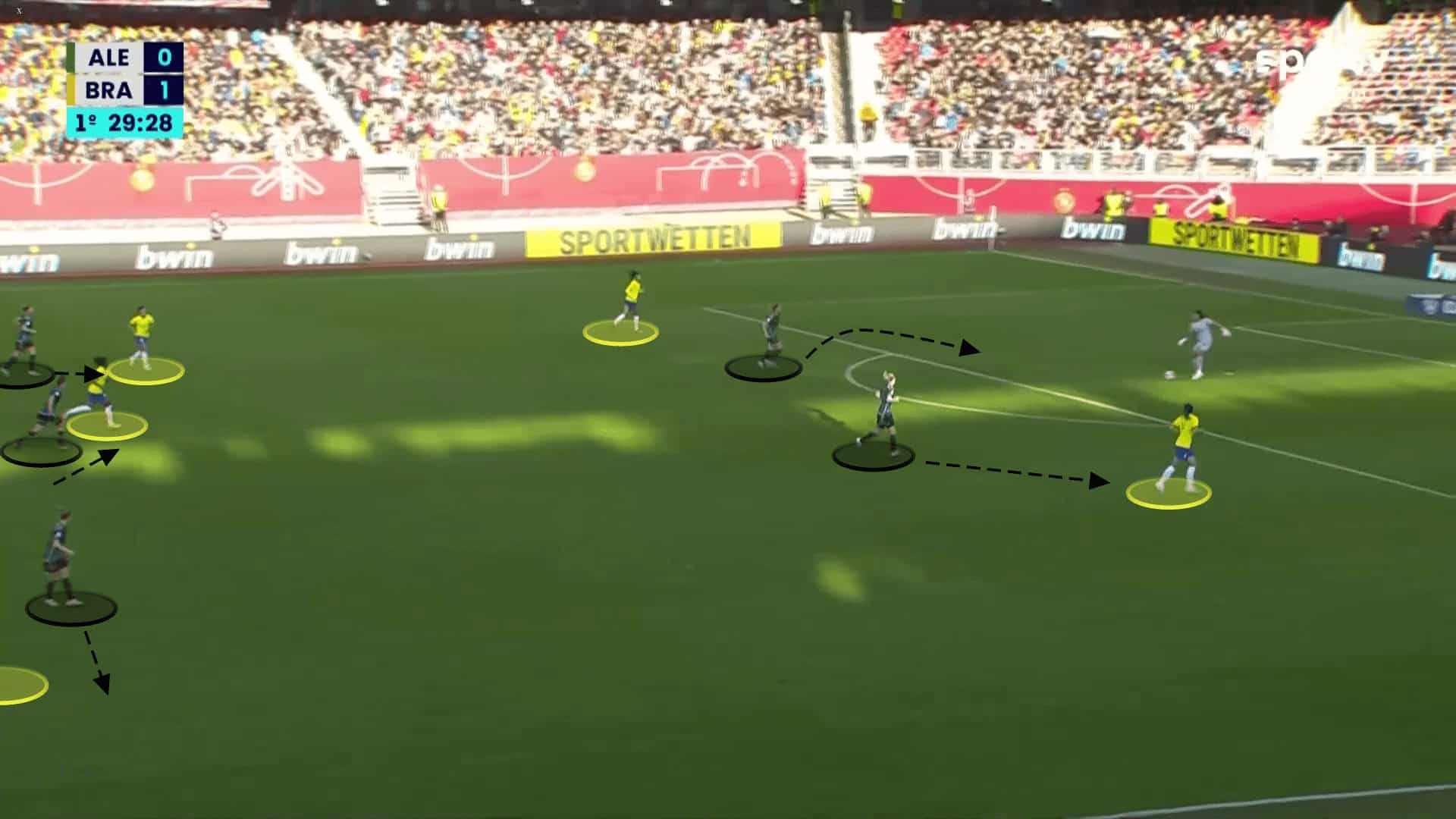
Germany adopt a 4-1-4-1 defensive shape. Their defensive approach is primarily position-oriented, aiming to channel the opponent towards one side of the pitch. Players shift towards that side from the centre and the opposite wing, creating a compact trap that restricts the opposition’s passing options and prevents them from switching the play.
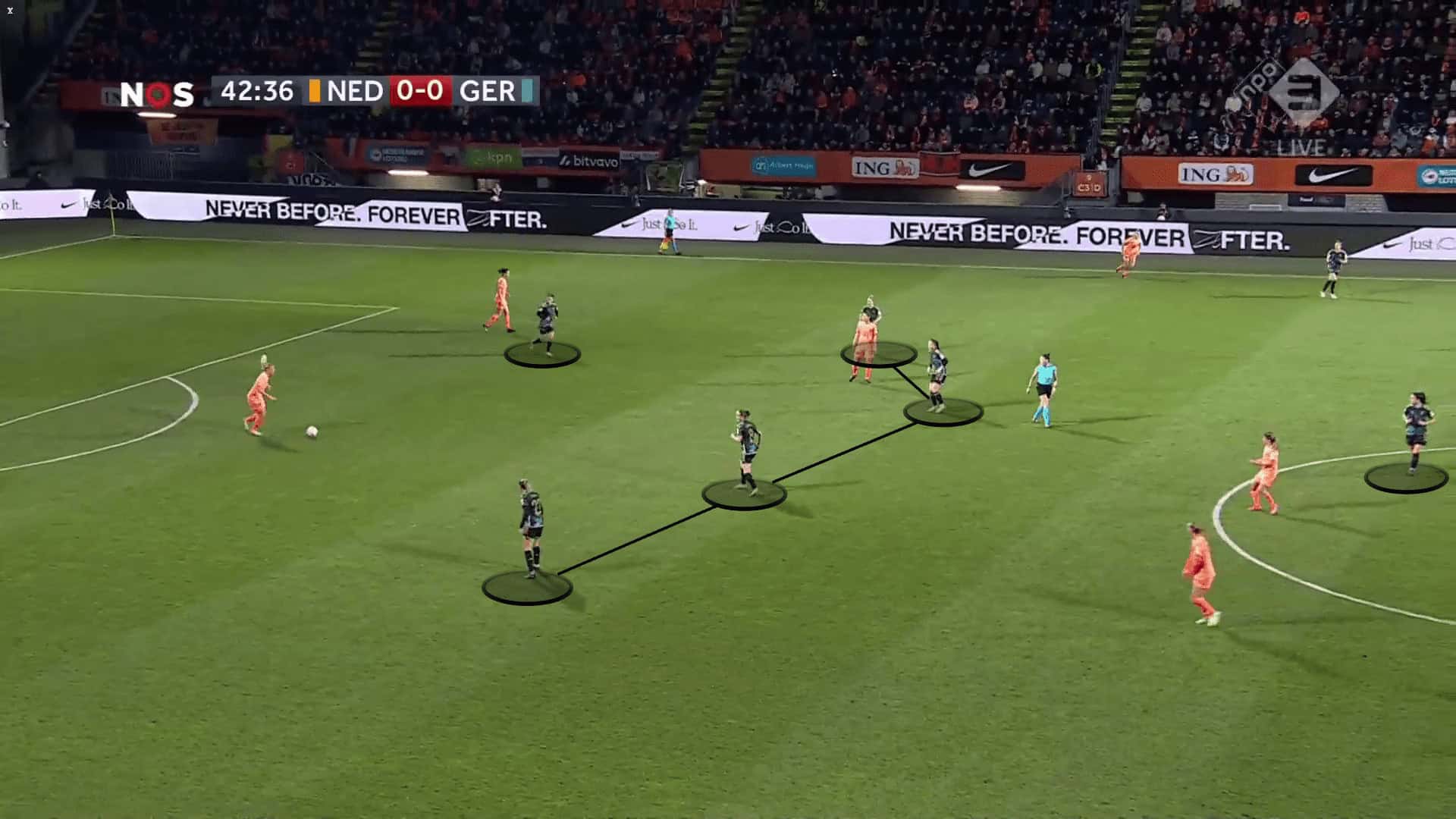
Overall, Germany’s ability to press aggressively and force turnovers near the opposition’s goal contributes to their attacking prowess and defensive effectiveness under Voss-Tecklenburg’s tactical philosophy.
Transitions
In the upcoming section, we will delve into Germany’s performance in transitional phases. This analysis will focus on their ability to transition from defence to attack and vice versa. To provide a comprehensive understanding, we will examine specific instances from game footage, drawing insights from our video analysis of Voss-Tecklenburg’s team in action. By examining these examples, we can gain valuable insights into Germany’s effectiveness during transitional moments on the pitch.
As Germany enters the phase of chance creation, their full-backs tend to position themselves on either side of the front three. Apart from the full-backs, Germany’s shape aligns with expectations for a 4-3-3 or 4-1-4-1 formation. The two centre-backs form a foundation for the team’s buildup, while the midfield triangle sits just ahead of them, with the holding midfielder positioned slightly deeper.
Germany’s chance creation phase involves the involvement of full-backs alongside the front three, while the team’s defensive shape relies on a strong foundation provided by the centre-backs and a disciplined midfield. Effective counterpressing and defensive intensity are crucial for Germany to mitigate weaknesses in their transitional play.
In terms of defence, the midfielders play a crucial role in maintaining spatial awareness, making effective decisions, and possessing the necessary physical attributes as the opposition attempts to penetrate through the centre. Voss-Tecklenburg emphasises high-intensity counterpressing and aggressive defence to regain possession as far up the pitch as possible, away from their own goal. However, if the press is not executed effectively, there is a risk of the opposition exposing Germany in transition and exploiting spaces left open for forward passes. This vulnerability could be targeted by opponents during the upcoming tournament, making it an area of concern for Germany.
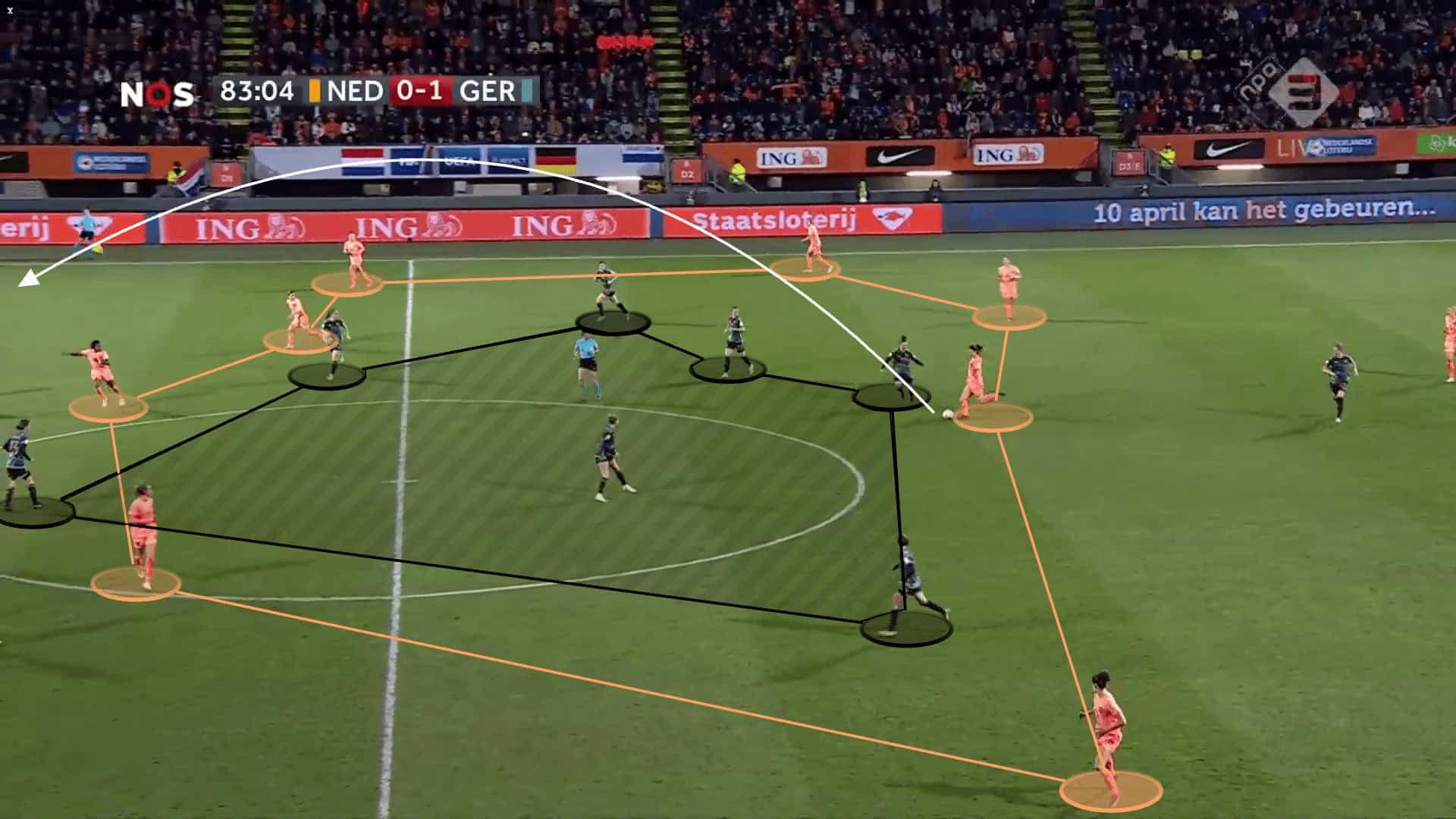
Those selected to start under Voss-Tecklenburg must excel at pressing proactively and be comfortable tracking back to support the deeper defensive positions if needed. Germany’s winger drops deep to support in defence. As the play progresses, the winger successfully retrieves possession from the opponent’s wide ball carrier, showcasing commendable defensive effort. One winger proceeds to engage in a quick one-two with the central midfielder near the ball. From this position, the winger can deliver a precise through ball around the outside of the opposing team’s widest defender, targeting the centre-forward’s run.
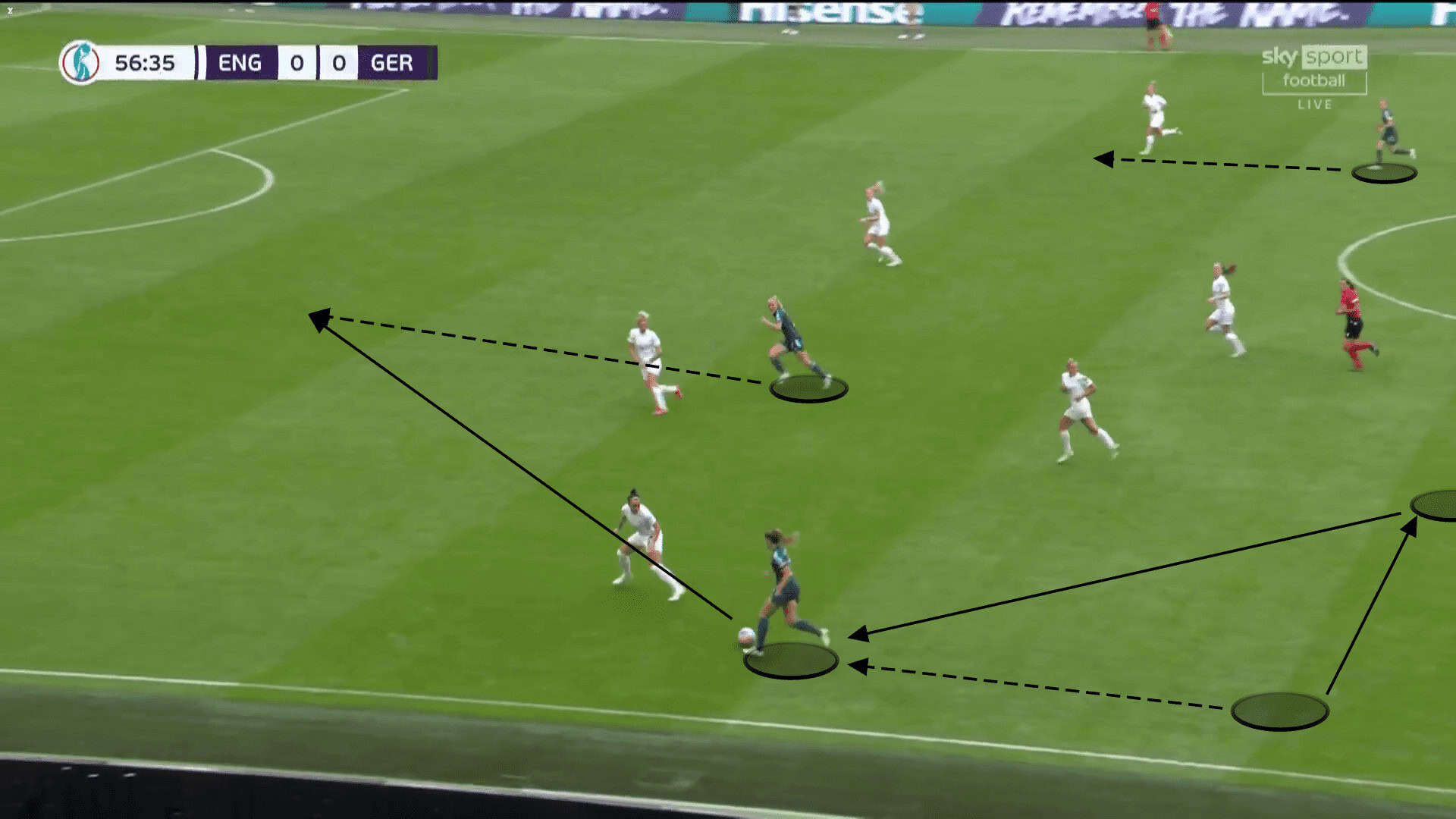
It’s worth noting the recurring pattern of in-to-out running and angled movements between opposition defenders from Germany’s attackers. This type of run is commonly seen during both settled attacks and transitions, aligning well with Germany’s preference for breaking into the final third through wide overloads.
Germany emphasises a collective defensive effort, even from their forwards. The ability to press assertively and provide defensive support is crucial. The attacking players, particularly the wingers, demonstrate a willingness to contribute defensively and exhibit intelligent movements that complement Germany’s wide attacking approach.
Defenders
Germany boasts a formidable defensive unit, comprised of experienced and talented defenders who provide stability and resilience at the back. Led by Felicitas Rauch, Marina Hegering, Kathrin Hendrich, and Sophia Kleinherne, Germany’s defensive line is well-equipped to handle the challenges posed by top international opponents.
Felicitas Rauch, at the age of 27, brings a wealth of experience and versatility to the left-back position. Known for her tenacity and excellent positioning, Rauch excels in both defensive duties and overlapping runs to support the attack. Her ability to contribute in both areas of the game makes her a valuable asset to the team.
Marina Hegering, a 33-year-old centre-back, provides a commanding presence in the heart of the defence. Hegering’s leadership qualities and exceptional progressive passing make her a vital component of Germany’s defensive organisation. Her ability to read the game and make crucial interceptions and passes contributes to the team’s defensive solidity and attacking game.
Kathrin Hendrich, aged 31, is another integral member of Germany’s defence, occupying the right-centre back position. Known for her physicality and defensive intelligence, Hendrich excels in one-on-one situations and displays excellent positional awareness. Additionally, her ability to initiate attacks from the back with accurate long passes adds a valuable dimension to Germany’s gameplay.
Completing the defensive quartet is the young and talented Sophia Kleinherne, aged 23, who primarily operates as the team’s right-back. Kleinherne combines defensive solidity with attacking intent, often overlapping and providing width down the right flank. Her speed, technical ability, and accurate crosses make her a constant threat in the final third. Her passing game is solid.
On the bench, Germany possesses additional defensive options. Sara Doorsoun, 31, brings experience and versatility as a centre-back or right-back. Sarai Linder, at the age of 23, offers promising potential in central defence, while Carolin Simon, aged 30, provides reliable backup at the full-back position.
Collectively, Germany’s defenders exhibit strong defensive discipline, tactical awareness, and the ability to win duels. Their understanding of each other’s strengths and playing styles enables them to function cohesively as a unit, forming a formidable barrier for opposing attackers.
Germany’s defensive line is not only adept at nullifying the opposition’s threats but also contributes to the team’s attacking play through their ability to initiate build-up from the back. Their composure under pressure and distribution skills allow them to launch quick and efficient counterattacks.
Midfielders
Germany boasts a talented and versatile midfield unit, with a combination of experienced players and rising stars. In the starting lineup, Lena Oberdorf, Sara Däbritz, and Lina Magull provide the team with a strong foundation in midfield, while the bench options of Paulina Krumbiegel, Chantal Hagel, Melanie Leupolz, Sydney Lohmann, and Lena Lattwein offer depth and variety.
Lena Oberdorf, at just 21 years old, has already established herself as a key player in Germany’s midfield. Operating in a central midfield role, she brings energy, athleticism, and excellent technical ability to the team. Oberdorf’s versatility allows her to contribute both defensively and offensively, making crucial tackles and interceptions while also showcasing her passing range and ability to drive forward with the ball. Oberdorf will play a crucial role in Germany’s midfield, providing a deep passing option for the defence and linking up with her teammates. Her ability to progress the ball will be valuable in the team’s style of play.
Sara Däbritz, 28 years old, is a seasoned midfielder who brings experience and composure to Germany’s midfield. Often deployed in a left-central midfield position, Däbritz possesses great vision and passing ability. She combines her creative instincts with a tenacious work rate, contributing defensively while also making incisive runs into the final third. Däbritz is a skilled player in maintaining possession and can also contribute to ball progression. She will have the freedom to move forward and provide support to the attacking players, while also dropping deep to assist Oberdorf when needed. Däbritz’s leadership qualities and ability to score crucial goals make her an invaluable asset to the team.
Lina Magull, also 28 years old, operates in a right-central midfield role, adding creativity, technical prowess, and goal-scoring ability to Germany’s midfield. Magull’s excellent ball control and dribbling skills enable her to break through defensive lines and create scoring opportunities. Magull has the ability to provide accurate through balls behind the opposition’s defensive line, effectively setting up the attacking players who make runs from inside to outside positions. Her ability to combine well with teammates and find pockets of space makes her a valuable asset in orchestrating Germany’s attacks.
On the bench, Paulina Krumbiegel, Chantal Hagel, Melanie Leupolz, Sydney Lohmann, and Lena Lattwein provide a wealth of options and versatility. Krumbiegel, aged 22, possesses dynamic attributes and a strong work ethic. Hagel, 24 years old, brings creativity and vision to the midfield. Leupolz, 29 years old, offers experience and solidity in both defensive and attacking aspects of the game. Lohmann, at the age of 22, displays great potential with her technical ability and versatility. Lattwein, aged 23, contributes with her physicality, energy, and ability to cover multiple positions in midfield.
Collectively, Germany’s midfielders provide a balanced combination of defensive solidity, creativity, and goal-scoring threat. Their ability to control the tempo of the game, dictate play, and provide crucial link-up play between defence and attack is vital for Germany’s success. They demonstrate excellent positioning, tactical discipline, and the ability to win duels in midfield.
Germany’s midfielders not only contribute to defensive stability but also play a significant role in creating goal-scoring opportunities and facilitating the team’s attacking play. Their vision, passing range, and ability to make intelligent runs into the box make them a constant threat to the opposition.
Attackers
Germany’s forward line showcases a formidable combination of experience and youthful talent. In the starting lineup, Svenja Huth, Alexandra Popp, and Jule Brand form a dynamic trio, while the bench options of Lena Lattwein, Nicole Anyomi, Klara Bühl, Laura Freigang, Lea Schüller, and Tabea Waßmuth provide depth and versatility.
Svenja Huth, aged 32, takes up one wing position, bringing passing skills, agility, and a keen eye for goal to Germany’s attacking line. Her ability to take on defenders with her dribbling skills and provide accurate passes makes her a constant threat to the opposition. Huth’s experience and work rate add valuable contributions to both the team’s attacking and defensive phases.
Alexandra Popp, also 32 years old, might operate as the central forward, spearheading Germany’s attacking efforts. Popp’s physical presence and flexibility make her a false 9. Her positional awareness, intelligent movement, and ability to hold up play contribute to the team’s overall attacking fluidity. Popp’s experience and leadership qualities make her a valuable asset in guiding the younger players.
Jule Brand, at just 20 years old, showcases her immense potential and ability on the wing. Brand is considered the top choice for the position due to her creativity, strong dribbling skills and ability to make runs in behind the defence. She excels in this role and provides valuable attacking contributions to the team. Brand’s speed, technical skills, and ability to take on opponents in one-on-one situations provide a dynamic dimension to Germany’s attacking play. Despite her young age, Brand has already displayed maturity and composure beyond her years, making her a promising talent for the future.
On the bench, Lena Lattwein, Nicole Anyomi, Klara Bühl, Laura Freigang, Lea Schüller, and Tabea Waßmuth offer a range of options and depth in Germany’s forward line. Lattwein, 23 years old, possesses versatility and the ability to play in multiple positions in the attacking third. Anyomi, also 23, demonstrates pace, technical ability, and a knack for finding the back of the net. Bühl, 22 years old, showcases her speed and goal-scoring instinct as a potent attacking threat. Freigang, aged 25, contributes with her intelligent movement and ability to create chances for herself and her teammates. Schüller, 25 years old, offers a strong physical presence and an eye for goal. Waßmuth, at the age of 26, brings technical ability and tactical awareness to the forward line.
Collectively, Germany’s forwards possess a combination of speed, skill, goalscoring instinct, and versatility. Their ability to create chances, provide assists, and score goals will be crucial for Germany’s success in the World Cup. They possess the creativity and firepower to unlock defences and trouble opposing goalkeepers consistently.
Germany’s forward line not only poses a threat in terms of goalscoring but also contributes to the overall team dynamics. Their off-the-ball movement, positional awareness, and ability to press opponents relentlessly add an extra dimension to Germany’s attacking play.
Key player
Alexandra Popp, the captain of Germany’s women’s national team and a prominent player for VfL Wolfsburg, is a key figure with a wealth of experience. At 32 years old, she possesses a versatile skill set that makes her a valuable asset on the field. Popp’s primary position is as a centre-forward, where she thrives as a false 9. However, her adaptability allows her to excel as a central attacking midfielder or even a central midfielder.

Popp’s well-rounded abilities make her a clever player and a constant threat in front of goal. She boasts a high shot output and demonstrates a remarkable ability to find herself in the opposition’s box, consistently making an impact. Her creativity is evident in her passing statistics, which highlight her proficiency in delivering dangerous and precise passes. As a target player for the German team, she often becomes the focal point of their attacking play.
One notable aspect of Popp’s game is her aerial prowess. She fearlessly engages in numerous aerial duels and tends to come out on top more often than not. This ability adds another dimension to her game, allowing her to win aerial battles and create opportunities for her team.
What sets Popp apart is her astute movement and positioning on the pitch. She displays a high level of football intelligence, constantly finding gaps in the opposition’s defence and exploiting them to her advantage. Her ability to read the game and position herself effectively makes her a constant threat to opposing teams.
Alexandra Popp is a vital player for Germany’s women’s national team. As the team’s captain, she brings invaluable experience and serves as a role model for her teammates. Popp’s versatility, goalscoring prowess, creativity, aerial dominance, and intelligent movement make her a standout performer. Her all-around skills and adaptability contribute significantly to her team’s success.
Tournament Prediction
Predicting the outcome of a tournament is always challenging, but based on the strength and potential of the German Women’s National Team, they are expected to be serious contenders in the World Cup 2023. With a blend of experienced players and emerging talents, Germany possess a solid foundation to make a deep run in the tournament. Their roster includes skilled goalkeepers like Merle Frohms and Ann-Katrin Berger, providing stability at the back.
However, it’s important to note that the World Cup is a highly competitive tournament, and there are many strong teams vying for the title. Other powerhouses like the United States, Netherlands, and England will also be strong contenders. Additionally, unexpected surprises can always occur in football, making it unpredictable.
Nonetheless, with their rich footballing history, tactical astuteness, and talented squad, Germany’s Women’s National Team has the potential to reach the later stages of the tournament and contend for the World Cup title in 2023.





Comments